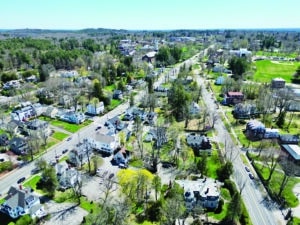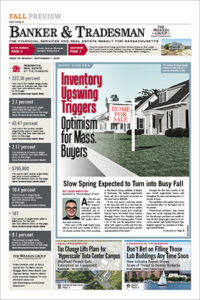
Could any of these Andover houses be worth $1 million? Quite possibly: The town’s median single-family sale price sits at $1.07 million so far this year and hit $1 million last year. iStock photo
One of the Boston area’s most expensive yet fastest-growing clubs, will cost you seven figures to join.
Fortunately, if you don’t have the cash on hand, you can spread your payments over 30 years.
That would be the million-dollar town club: Boston-area suburbs where the median sale price of a home now tops $1 million.
A once-exclusive fraternity, the number of towns where seven-figure sale prices are the norm has exploded as Greater Boston’s affordability crisis has gone from bad to worse in the last few years, data from Banker & Tradesman’s publisher The Warren Group shows.
More than 50 towns in the Boston area, on the Cape and Islands, and in the Berkshires now have median prices of at least $1 million, with some now in the $2 million and $3 million range.
In fact, the number of million-dollar towns has nearly tripled since early 2020 in the early days of the pandemic, when there were 18.
And go further back to 2010, a mere 15 years ago, and there were just four communities in the million-dollar club: Brookline, Weston, Nantucket and Chilmark on Martha’s Vineyard. Add in downtown Back Bay and downtown Boston, and you have five.
Where to Find Them
Membership today in the million-dollar club has expanded well beyond a few elite suburbs like Wellesley, Weston, Brookline, Winchester, Newton, Hingham, Lexington and Concord.
As of April 30, it now includes places that were never in anyone’s list of super-posh places to live, towns like Hingham, Westwood, Wayland, Boxboro, and Westford.
And it is a club whose membership is likely to continue to grow exponentially given the anemic levels of new residential construction, both in the Boston area and across the state.
“We need to ask ourselves whether we want those median home prices to be $2 million or $3 million in 20 years,” said Andrew Andrew Mikula, senior housing fellow at the Pioneer Institute for Public Policy Research.
Prices have surged in upscale towns, suburbs and resort communities as residential construction has continued its bumpy, decades-long decline from its peak in the 1980s.
Back then, Massachusetts was about middle of the pack nationally when it came to single-family and apartment construction.
At the peak of the 1980s heated real estate market, builders were breaking ground on 30,000 to 40,000 new homes each year.
We’ll be lucky if we break 10,000 this year.
There’s One Big Reason Why
The dearth of new construction has led to a chronic shortage of homes for sale and has been the key factor in driving prices to ever crazier levels.
“The bigger challenge is that most of the new construction or rehabs are toward the higher end of the price range in many communities, including Boston,” said Sam Schneiderman, principal broker of the Greater Boston Home Team. “Even the historically less expensive neighborhoods are now at the tipping point of unaffordability, with many Boston neighborhoods already surpassing the million dollar mark.”

Scott Van Voorhis
The slowdown in new residential construction has been particularly noteworthy in many of the posh suburbs and towns that make up the million-dollar club.
Deep-pocketed neighbors have the resources to spend years tying up plans for new housing in court, and local officials are too often only happy to oblige with endless project reviews.
Much new construction in the priciest towns is now taking the form of teardowns of older, more modest homes to make way for McMansions.
That’s not adding to the overall supply of housing, that’s subtracting from it.
“There are still dozens of state and local friction points that prevent the market from meeting housing demand, as spelled out in the [Healy administration’s] Unlocking Housing Production Commission report,” said Clark Ziegler, executive director of the Massachusetts Housing Partnership. “In combination, those policies drive development toward large-lot single-family homes rather than more compact development like townhomes and modest single-family homes on small lots.”
Scott Van Voorhis is Banker & Tradesman’s columnist and publisher of the Contrarian Boston newsletter; opinions expressed are his own. He may be reached at sbvanvoorhis@hotmail.com.






